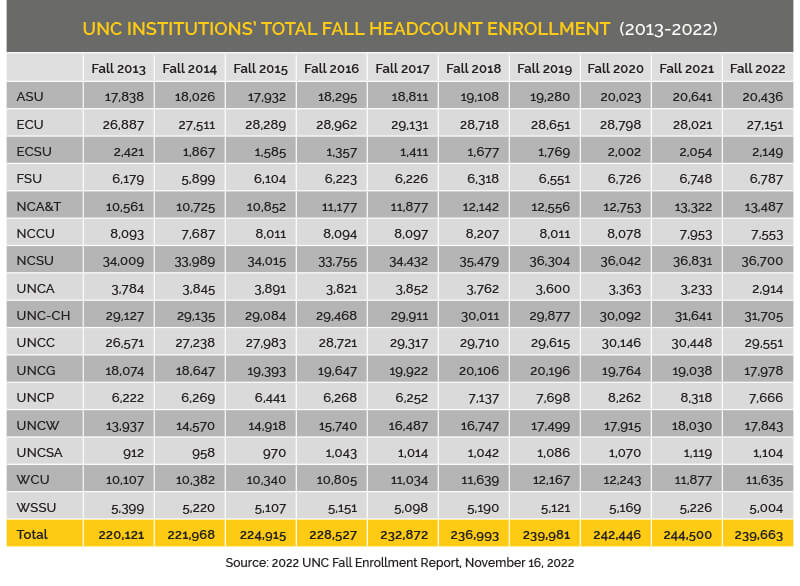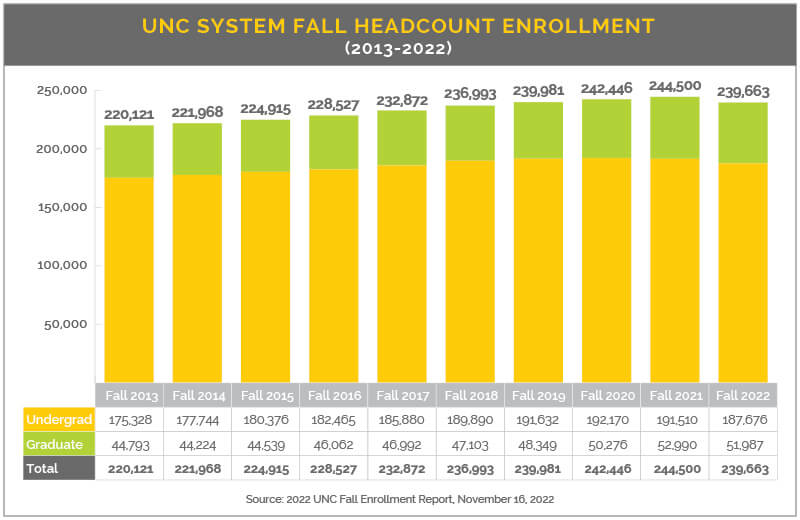Enrollment down across UNC System
Published November 17, 2022
For the first time in nine years, the UNC System saw enrollment decline this fall, according to a new report.
Because public universities currently receive state funds based largely on their enrollment, that could mean financial reductions for some. But the UNC Board of Governors is working to soften the blow, chiefly by raising the out-of-state enrollment cap at five more of the System’s 16 institutions.
The total headcount across the System for Fall 2022 was 239,663 students – a decrease of 4,837 students, or almost 2%. Undergraduate enrollment declined by 3,834, or 2%, from 2021 to 2022. Graduate student enrollment declined by 1,003 students, or 1.89%.

Twelve of the System’s 16 institutions saw enrollment decline this fall, while four – Elizabeth City State, Fayetteville State, N.C. A&T and UNC-Chapel Hill – increased enrollment.

UNIVERSITY OFFICIALS CITE multiple factors in the decline:
- Demographics. Birth rates declined during the Great Recession, producing fewer high school graduates nationwide. In particular, the number of graduates was projected to dip 5.6% with the graduating class of 2022. The number of high school graduates in North Carolina is projected to climb until 2026, then decline from 2026 to 2030 before stabilizing at about 114,000 a year – roughly the equivalent of the 2018 graduating class. Because states in the Northeast, Midwest and West are projected to see an even larger decline of 243,000 graduates by 2037, universities in those regions can be expected to aggressively recruit students from the South, including North Carolina.
The number of high school graduates in North Carolina is projected to decline from 2026 to 2029-30 before stabilizing at about 114,000 a year – roughly the equivalent of the 2018 graduating class. The Northeast, Midwest and West are projected to face a decline of 243,000 graduates by 2037, so universities in those regions can be expected to aggressively recruit students from the South, including North Carolina.
- Community College enrollment. Enrollment at North Carolina community colleges fell during the coronavirus pandemic, mirroring national trends. This produced the lowest number of transfer students to the UNC System – 15,623 in 2022 – since the fall of 2013.
- Perceived value. “The combined impacts of the COVID- 19 pandemic, demographic shifts, and a weakening in the perceived value of a college degree are affecting enrollment at our institutions,” the report says. “While we do not yet know the full future impact of these extraordinary circumstances, we do know that they are having an impact on our enrollment today and the impact will continue in the years to come.”
THE UNC SYSTEM’S student body is growing more diverse, however. Since 2013, the percentage of students from underrepresented minority groups has increased from 29.1% to 34.7%.
The largest increase was among students who identify as Hispanic or Latino, who grew from 4.7% to 8.7% of UNC System students.
Officials say demand from out-of-state students to attend UNC System schools was “unprecedented” this year. Four institutions – N.C. A&T (41%), NC State (19%), UNC Wilmington (20%) and Western Carolina (22%) – exceeded their respective caps on out-of-state enrollment.1
The Board of Governors voted today to fine N.C. A&T nearly $2 million for exceeding its 35% out-of-state cap two years in a row.2 Board member Joel Ford opposed the penalty, saying the Board should not punish A&T for its success, especially as other state schools struggle to maintain enrollment.
In April, the Board increased out-of-state enrollment limits to 25% at Fayetteville State and Winston-Salem State, 35% at A&T and NC Central, and 50% at Elizabeth City State University.
In part to address the broader enrollment decline, the Board of Governors’ Educational Planning Committee recommended Wednesday that the Board increase the out-of-state cap from 18% to 25% at five more institutions:
- East Carolina University
- UNC Asheville
- UNC Greensboro
- UNC Pembroke
- Western Carolina University.
David English, the System’s Acting Senior Vice President for Academic Affairs, said the increase could mean 544 additional out-of-state students at the campuses. But the five institutions collectively have room for an additional 11,000 students.
“The capacity is already there,” English said. “We do not believe this will displace any North Carolina student.”
The enrollment declines have been most pronounced at UNC Greensboro, UNC Asheville and UNC Pembroke. The Board’s Budget and Finance Committee recommended that the Board limit budget cuts based on enrollment to 4.5% over two years.
Without the “stop-loss” policy, UNC Greensboro would face state budget reductions of $11.2 million (6.2%) over two years. With the 4.5% cap, however, its cut would be limited to $8.2 million.3
1 https://www.northcarolina.edu/apps/bog/doc.php?id=67063&code=bog, pp. 8-22.
2 https://www.northcarolina.edu/apps/bog/doc.php?id=67049&code=bog, pp. 19-21.
3 https://www.northcarolina.edu/apps/bog/doc.php?id=67049&code=bog, pp. 15-18.







